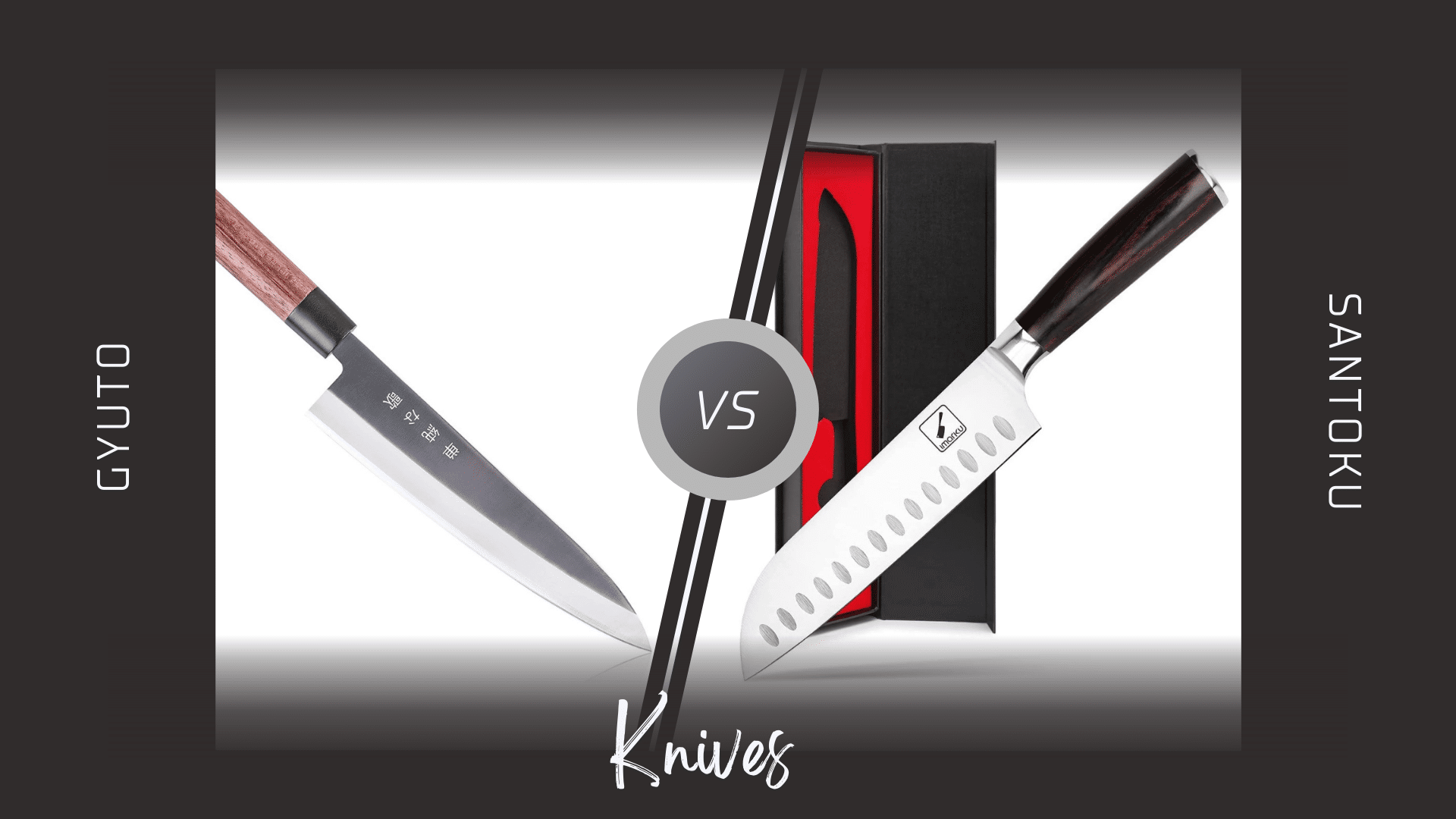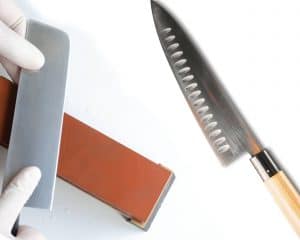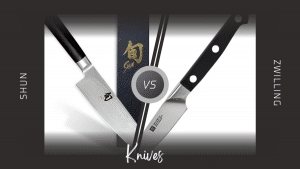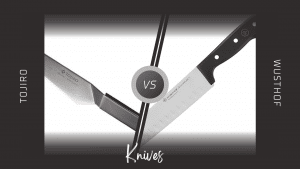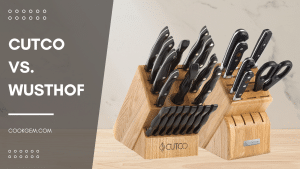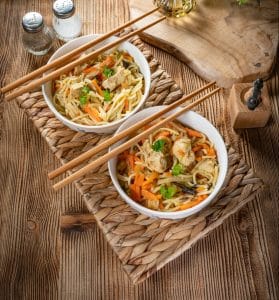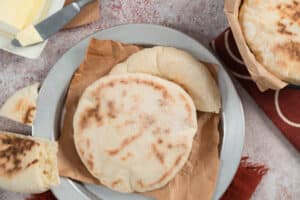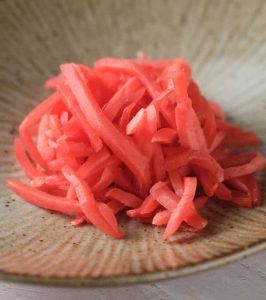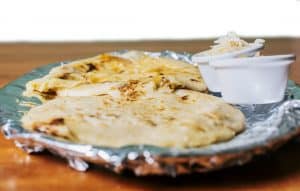Gyuto vs. Santoku Knives: What’s The Difference?
Important Note: When you buy through our links, we may earn a commission. As an Amazon Associate we earn from qualifying purchases. Content, pricing, offers and availability are subject to change at any time - more info.
You finally get to the homeware store or sit down and open your online shopping website. You are on a search for a new knife. There are so many options. Which one should you choose? Gyuto vs. Santoku – is one more superior to the other?
Gyuto is a Japanese name for ‘beef sword,’ and the classic Western Chef’s knife is used as an all-purpose blade for meats, fish, and vegetables. Santoku means ‘3 virtues.’ It comes from the “3 uses” of the knife of chopping, dicing, and mincing. Gyuto knives are more versatile than Santokus.
There are several differences between Gyuto and Santoku knives, even with their significant similarities. When comparing the two, you want to distinguish all their characteristics, such as price point, material, and uses, to get the best option for your needs. We have put together all the information in detail below.
- Gyuto vs. Santoku: Key Differences
- What is a Gyuto Knife?
- What Is A Santoku Knife?
- Gyuto Knife Uses
- Santoku Knife Uses
- The Design & Weight Of Gyuto Knives
- The Design & Weight Of Santoku Knives
- Is Gyuto Or Santoku Better For Cutting Meat?
- Quality Of Gyuto vs. Santoku
- Is Gyuto Or Santoku More Affordable?
- Gyuto vs. Santoku: Which Is Better?
- Similarities Of Gyuto & Santoku Knives
- Gyuto vs. Santoku: Can One Replace The Other?
- What’s The Diferrence Between Gyuto & Santoku
Gyuto vs. Santoku: Key Differences
Take a look at some of the main differences between Gyotu and Santoku knives:
| Gyuto Knives | Santoku Knives |
| Generally longer | Can be shorter |
| Multifunctional | Less versatile |
| Curved edge | Straight edge |
| Originates in Europe | Originates in Japan |
| Sharper pointed tip | No pointed tip |
| Double bevel | Mostly single bevel |
There are other differences between the 2 knives, but these are the most significant. We will discuss more in the course of the article.
What is a Gyuto Knife?
A Gyuto knife comes from the Japanese version of a western chef’s knife originating from Europe — Germany of France. Towards the later 19th century, German and French knives were imported to Japan, and the Japanese manufacturers began to copy the product, calling them Gyuto (beef sword).
The name came about because the knives were used for larger meat chunks, and the blades were convenient for meat handling.
The Gyuto knife is a multifunctional knife with a sharp-pointed tip and curved edge, making it easier to cut into meat and cutting techniques like mincing more effortless.
What Is A Santoku Knife?
A Santoku knife originated from Japan and was invented from the Nakiri version specializing in cutting vegetables. The Nakiri was also most popular before the making of Santoku knives. After World War 2, people cooked various foods – not only vegetables and needed more versatile knives.
Some found the Gyuto significantly different from the Nakiri, and the idea of the Santoku was birthed. They settled somewhere in the middle, so Santoku is a variant of the Nakiri and Chefs Knife.
Unlike the Gyotu that started from meat handling, the Santoku knife started from vegetable handling like the Nakiri.
Gyuto Knife Uses
There are several uses for a Gyuto knife, and it is well known as a highly multifunctional, versatile knife — even for professional chefs.
Here are uses for the Gyuto knife:
- Chopping
- Slicing
- Dicing
- Julienning
- Disjointing
- Mincing
Gyuto knives can be used for various foods such as meats, poultry, vegetables, fruits, greens, and even to chop small items such as garlic and cherry tomatoes.
They work well for cutting into larger and tougher meat pieces like steaks, and you can use them to disjoint bones such as ribs and poultry wings.
Santoku Knife Uses
A Santoku knife is versatile but not as multifunctional as the Gyuto. It is famous mainly for its versatility in home kitchens.
Here are uses for the Santoku knife:
- Mincing
- Dicing
- Chopping
- Slicing
While the knife is known for its ‘3 virtues’, you can use it in more ways. It works incredibly for thinly slicing because of its design.
The Santoku knife also works well for cutting softer, boneless meats and foods that require gentleness, like boiled eggs and cheese.
The Design & Weight Of Gyuto Knives
Design
The Gyuto knives are usually flat throughout, tall at their heel, and curved toward the tip. Gyuto is shaped the same as western chefs’ knives and used the same way. It’s nearly impossible to distinguish between slightly thicker Gyuto with a double bevel and a western-style handle from a western chef’s knife. Gyuto and chef’s knives are the same.
The edge curve at the tip of a Gyuto is more defined. The spine is less turned down compared to the Santoku. The direction of the spine makes the Gyuto blade’s tip faintly sharper. That is why they offer such clean, smooth cuts when joined and chopping meat and vegetables.
Weight
The weight of Japanese knives plays an essential part in deciding their ease of use. The material of the blade and handle and the total size are the two main things contributing to the total weight.
Due to the larger size of the Gyuto knives, they are heavier than the Santoku knives, and you can optimize them in preference for business use.
The Design & Weight Of Santoku Knives
Design
The Santoku is a well-rounded knife that excels at slicing, dicing, and mincing and is the most common knife shape you will find in kitchens worldwide. It is generally short in length, between 6-7 inches.
They are usually shorter than long chef knives (less than 8 inches) and have broad, flat blades and fairly blunt or slightly rounded tips. As a result, they’re not very well suited for piercing. With no belly (or curve), you can’t rock cut with them either.
The straight blade of a Santoku is handy for long cutting strokes. The wide edge helps for transferring food, too. These qualities are especially good for chopping. Santokus tend to be thin, stiff, and very sharp like most Japanese knives. Some Santokus have an asymmetric grind – that means you can only use them in either your right or left hand. Others have a hollow grind for extra sharpness.
Weight
Both knife types are constructed from identical substances, but the Santoku is lightweight due to its smaller size than the Gyuto. The compact Santoku knives are ideal for household usage.
It is necessary to note that sometimes manufacturers produce santoku knives in large makes that match the Gyuto to make them more functional. So they can be very similar to the weight of the Gyuto. It depends on what size and makes you are looking to get.
Is Gyuto Or Santoku Better For Cutting Meat?
Gyuto and Santoku knives are excellent for cutting meats; however, it also depends on what types of meat you are looking to cut.
For bone-in meats:
The Gyuto is the better option because the entire knife’s purpose is made for meat handling – from the design to the materials to the shape of the blade. You can even use a Gyuto knife to disjoint certain meats with little effort.
For soft boneless meats:
The Gyuto and Santoku can work for cutting boneless meats; however, due to the design of the Santoku and its seamless cutting of fragile vegetables, you can use the blade for soft proteins. It is fantastic if you don’t need to cut tough meat pieces and already use a Santoku knife for ease in your home kitchen with vegetables.
Quality Of Gyuto vs. Santoku
The quality of both knives is pretty decent, and the purpose of comparing them should be purely to choose what will work best for your knife requirements personally.
With that said, you will often find the quality of Gyuto knives rated higher because of their ability to withstand complicated and challenging techniques with their all-around cutting power.
Both knives are made with identical materials (high carbon stainless steel), but the Gyuto is typically larger. Some manufacturers now make Santoku knives that match the Gyuto size, but its general scope is small. You will find the Gyuto slightly pricier because of that too.
The Santoku knife is slightly more lightweight because of its smaller size, but that doesn’t mean it is of lower quality. If you use each knife for its stipulated cutting abilities and do not force your Santuko to cut through a bone, both blades will last you a long time and maintain their quality.
Is Gyuto Or Santoku More Affordable?
The Gyuto knife is priced higher, thus making the Santoku more affordable. The Gyuto knife is generally around 1-2 inches longer than the Santoku and typically has a double bevel, whereas the Santoku has a single – at least from most manufacturers.
Since the Gyuto knife is more versatile, the price is based on size, length, weight, and functionality. Santokus are around half the price of Gyuto knives.
Gyuto vs. Santoku: Which Is Better?
Before buying your Japanese knife, you have to look at all the specs and not only consider which blade has a higher rating or is more famous. You have to look at deeper details.
Here are some further details to consider before making your final decision:
What is the purpose of the knife for you?
That means what you intend on cutting with the knife. Do you need a Santoku because you will only cut vegetables and soft meats? May you grow your buy whole meat cuts and need to disjoint certain pieces yourself for which you will require a Gyuto.
What is your budget?
Does budget make a difference to you? Do you prefer having the pricier option, or do you shop frugally? If you want the higher price point knife, you can go for the Gyuto but if you want a more affordable option, go for the Santoku. As long as you are shopping smart, the choice depends on how deep you are willing to dig into your pockets.
What is easier for you to handle?
When you use something like a knife, especially one of such excellent quality and sharpness, you want to make sure you can handle it properly. Take the size of your hands and your strength into consideration. For small hands, the lightweight Santoku is a better option. For an experienced chef with expert knife skills, the Gyuto will work perfectly.
Where will you use the knife?
For a professional chef looking for a multifunctional option, there is no doubt you can go with the Chefs Knife (Gyuto). If you want a versatile knife for your home kitchen because you cook a lot, the Santoku is ideally a better option.
Similarities Of Gyuto & Santoku Knives
We have discussed the differences between the 2 knives and what separates them. Did you know they have a few decent similarities? That is why they come so close in comparison to each other.
Similarities of Gyuto and Santoku knives:
- They are both made by Japanese manufacturers, even though Gyuto originates from Europe.
- Both knives are made of high-carbon stainless steel.
- Even though the Gyuto might be slightly more multifunctional, they are both versatile knives, and you can use each of them for many cutting techniques.
- Some companies make Santoku knives double bevel like the Gyuto knives.
Gyuto vs. Santoku: Can One Replace The Other?
The direct answer to that would be no. Even though the knives have a few similarities and can cut pretty much cut almost all the same kinds of foods, you cannot replace one with the other.
The Gyuto knife is shaped and designed to make specific cutting techniques easier and quicker. An example technique would be the rock cutting motion when finely chopping and mincing vegetables. That is possible because of the curved edge and sharp pointy end.
The design of the Gyuto also makes it efficiently easy to cut and chop small veggies such as garlic and cherry tomatoes. You can get more precision due to the pointy end.
The Gyuto also allows you to work with tough protein cuts and disjoint bone-in meats. The Santoku won’t get that done.
The Santoku has its specialty too. The dimples along the blade allow seamless cutting and slicing, which helps prevent the knife from sticking in the vegetable. Santoku knives are known for making cutting produce easier. It is lightweight and also ideal for beginners.
What’s The Diferrence Between Gyuto & Santoku
Both knives are excellent choices. Focus on your needs and requirements before deciding what a better option for you is. Gyuto and Santoku knives will make your cooking experience a breeze.
Remember that Gyuto knives are more versatile but larger, heavier, and ideal for professional use. Santoku knives are lightweight, easy to use, and economical, making them perfect for home cooking.
